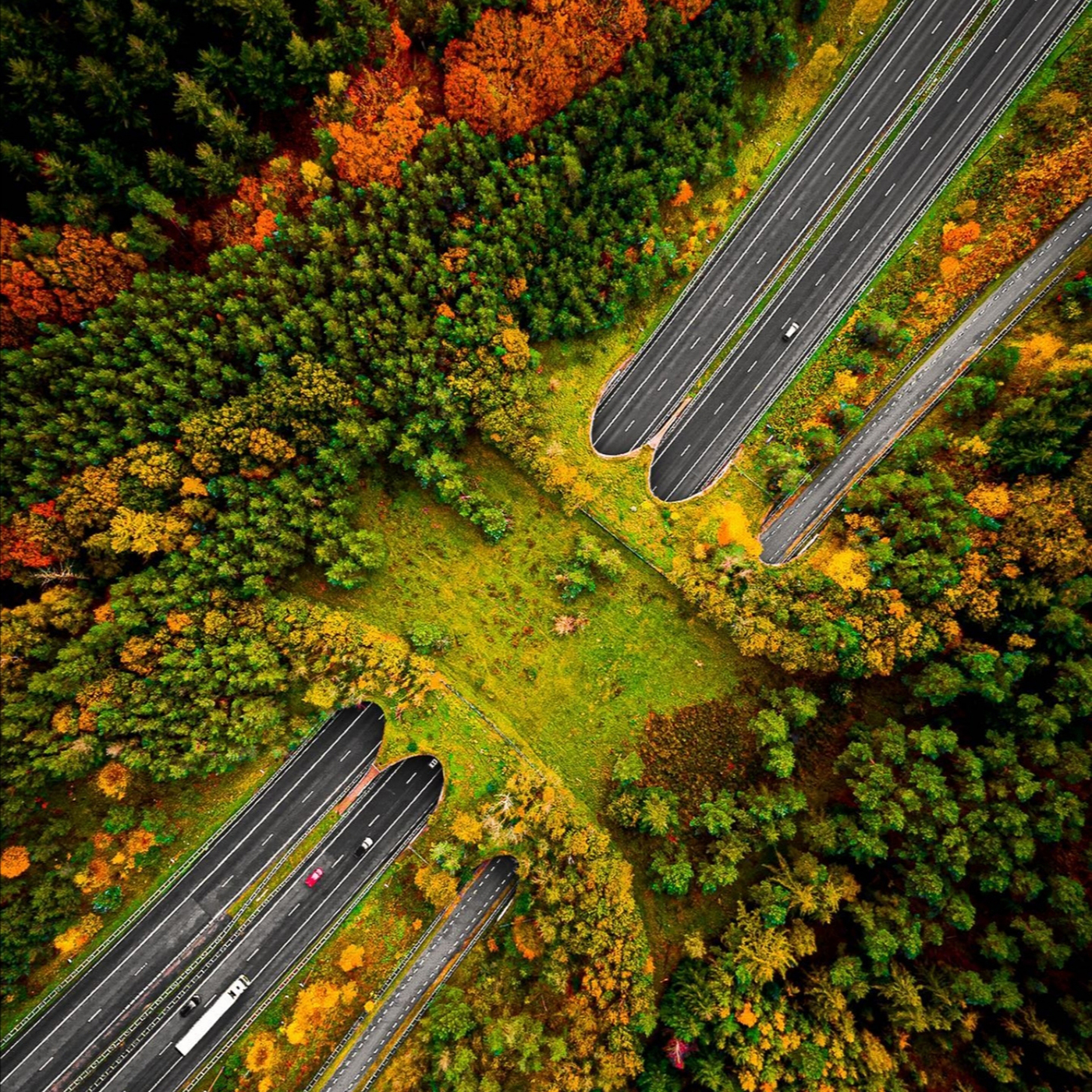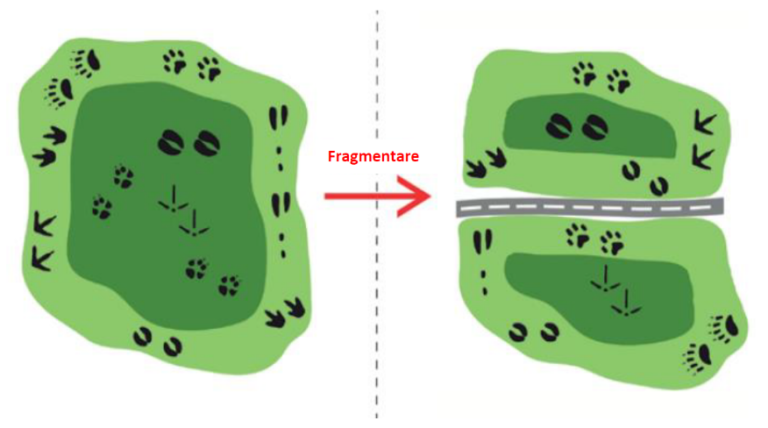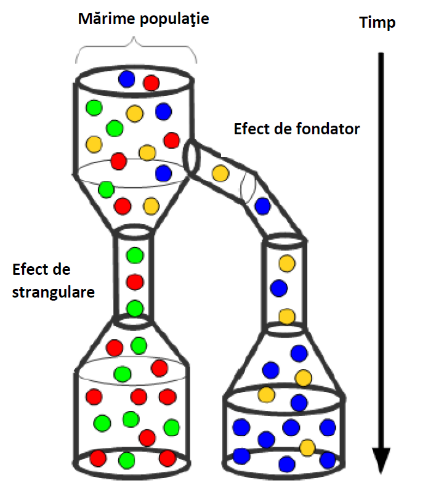In the current context of national infrastructure development, the impact on nature and its components becomes more pronounced through this trend. It is necessary to identify a balance between socio-economic development on one hand, and biodiversity conservation on the other hand.
Given Romania's commitment to respecting the ecological network of protected natural areas of Natura 2000 since 2007, it is necessary to take into account the following:
the need to protect the floristic and faunistic diversity of community interest when carrying out any infrastructure project on the territory of the country.
In this regard, the provisions of European directives have been transposed into national legislation through Emergency Government Ordinance no. 57/2007 on the regime of protected natural areas, the conservation of natural habitats, wild flora and fauna, approved with amendments and completions by Law no. 49/2011, with subsequent amendments and completions.
The barrier effect and habitat fragmentation
By carrying out a highway project that crosses a forested area, two separate forested areas will result, and wild fauna species, whose territory covers vast dimensions (examples), will be tempted to cross the anthropic structure in search of new territories for food, reproduction, and shelter (fig. 1).
This ultimately leads to the inevitable occurrence of accidents resulting in the loss of human lives, and in some cases, the reduction of wild fauna populations. Therefore, it is crucial to identify solutions to ensure the permeability of wildlife species, starting from the feasibility study phase, in order to prevent such occurrences.
Figure 1. Schematic representation of the habitat fragmentation effect [1]
In the absence of a detailed knowledge of an infrastructure project's interaction with the flora and fauna species in the area it crosses, correct and specific measures cannot be issued to reduce the impact caused by the construction works and the operation of the infrastructure. Therefore, it is absolutely necessary to engage a team of specialists in such projects, who will implement a series of monitoring methodologies and protocols for each component of biodiversity (habitats, invertebrates, ichthyofauna, herpetofauna, avifauna, mammals, chiropterans). Only in this way can all forms of impact caused by the implementation of the project be correctly identified and evaluated, and appropriate measures to reduce the generated impact can be formulated.
Also, the role of competent authorities for environmental protection must be emphasized, namely that of verifying environmental studies, as well as monitoring and controlling ongoing projects.
Infrastructure projects such as highways, railways or expressways represent permanent barriers for fauna species, causing the effect of fragmentation, in the absence of the implementation of constructive measures that allow them to over-cross and/or under-cross the communication path.
In specialized terms, the situation is reached where the "permeability" of wild fauna species is prevented, that is, their possibility to move freely on the natural territory is blocked.
A series of experiments have shown that most animal species are affected by the presence of a transportation route. Thus, invertebrates such as beetles and spiders are blocked by a narrow road (2.5 m), wider roads being a problem for larger animals, such as micromammals.
The probability of the latter crossing 6-15 m wide roads with low traffic is less than 10% of that of the species' refuge in adjacent habitats [2].
Therefore, it can be concluded that road width and traffic density are the determining causes of the barrier effect, if specific rules are not followed. The persistence of such a barrier can cause genetic changes over time on animal populations in the affected area.
Also, the cumulative impact of all the projects in the analyzed area must be taken into account, in order to prevent and reduce the "bottleneck" effect, i.e. strangulation of the evolution of the population of some species by preventing their reproduction. Figure 2 illustrates this phenomenon by means of a cylinder whose width represents the size of the population at a given moment, and the colored spheres inside it represent the different genes of the individuals belonging to the respective populations.
It can be seen how the "bottleneck" effect causes the loss of the genes represented by the yellow and blue spheres in the initial population, forming, in some cases, another population derived from the original one or a colony (the founder effect). Over time, the two distinct populations no longer have genes in common, which leads to the loss of genetic diversity.
Unlike natural selection, this phenomenon does not lead to the preservation and perpetuation of the best genes, which ensure the survival of the species, but on the contrary, it can lead to the appearance of individuals with weak genes, something that can even lead to the disappearance of the species over time.
Figure 2. Schematic illustration of the "bottleneck" and founder effects [3]
Solutions for the design of communication paths in harmony with nature
The planning, preservation, management, and design of environmentally friendly transportation infrastructure represent both technical and social challenges. This is not only a problem because of the increase in mortality rates for animal species but also because it practically constitutes an ecological barrier for all wild fauna species, including invertebrates, amphibians, reptiles, birds, and micromammals.
A correct approach should start with a thorough mapping of the proposed project implementation area in relation to natural habitats, ecological corridors, and wildlife populations. If the selected design solution cannot avoid environmentally sensitive areas, measures can be applied to reduce or compensate for the impact created.
An important argument also refers to the reduced financial effort of some works specific to the protection of fauna. For example, the cost for the construction of special wildlife crossings does not represent more than approx. 7-9% of the total costs associated with the execution of an infrastructure project [4].
The direct costs associated with transportation collisions with animals include vehicle repair costs, carcass collection and roadway cleaning costs, as well as medical costs involved. The indirect costs are not easily quantifiable, as they involve mortality among animal species, as well as serious injuries and even deaths among humans. In the United States of America, the expenses associated with traffic accidents caused by contact with wildlife were estimated at $146 million in 2001 [5].
The execution of such works during the exploitation phase of transportation routes is extremely difficult and as a result, their cost increases considerably. The price reduction can only be achieved through complex and efficient impact studies that are applicable in the field.
On a European level, continuous efforts are being made to implement a rigorous and carefully designed system of communication paths in harmony with nature. For example, we can mention the Netherlands, which built the first overpass for fauna (called "ecoduct") in 1988, and currently has at least 47 such ecoducts built throughout the country.
These are designed for all species of fauna, including amphibians (frogs, salamanders, newts) - for example, the Groene Woud ecoduct was designed to connect two wetland areas that constitute breeding habitats for amphibian species and to avoid the fragmentation and barrier phenomenon caused by a highway (fig. 3). As basic dimensional elements [6], it has a length of 65 m, a width of 50 m, and a construction height of 7 m.
The access ramps have a length of 110 m (west), 85 m (east) and a slope of 1:14 and 1:10, respectively. The soil used comes from the site, and on the lateral areas, perpendicular to the highway, 2.5 m high earth embankments were built to reduce the negative impact caused by light and traffic noise.
In our country, the first project that included solutions for wildlife permeability was the Lugoj-Deva highway, along which important crossing areas were necessary for mammal species, including large carnivores (fig. 4).
The Environmental Agreement issued by the National Agency for Environmental Protection for the "Lugoj-Deva Highway Section" project included the need to build 3 ecoducts on the section between km 27+620 - km 56+220, to ensure and maintain the permeability of species, so the highway route was optimized for this purpose [7, 8].
The constructive solutions for the creation of ecoducts in our country aim to avoid habitat fragmentation of species and to maintain their permeability within the ecological corridor that connects the Apuseni Mountains with the Southern Carpathians.

Figure 3. Groene Woud Ecoduct in the Netherlands [6]

Figure 4. Ecoduct built on the route of the Lugoj-Deva highway, lot 3
The conclusions
The planning, preservation, management, and design of environmentally friendly transportation infrastructure represent both technical and social challenges. This is not only a problem because of the increase in mortality rates for animal species but also because it practically constitutes an ecological barrier for all wild fauna species, including invertebrates, amphibians, reptiles, birds, and micromammals.
In a country with a rich fauna such as Romania, it is of great importance to identify critical areas where the phenomenon of fragmentation presents a high risk.
The increasing fragmentation of habitats will inevitably lead to high costs for restoring ecological corridors and wildlife populations. Therefore, the correct approach is to implement measures already at the feasibility stage of a project to avoid unfavorable consequences in terms of construction, finances, and traffic safety caused by ignoring this aspect.



